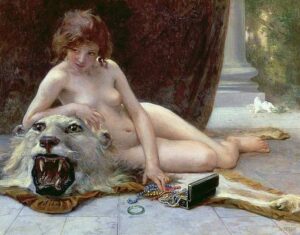Reading/Viewing Questions
John Berger’s Ways of Seeing Episode 2
After you watch episode 2 of Ways of Seeing (or even while you are watching it), provide short answers to the questions below.
- One of the main premises in this episode is Berger’s distinction between nakedness and the nude female form as it is traditionally represented in Western art. What are the differences between these things and why are these differences significant? Do they apply to images you have encountered in your experience?
John Berger in episode two of Ways of Seeing, he discusses the difference between nude and nakedness for a woman. He explains that nakedness is just the human female body without clothes. An appropriate example would be a woman in the shower by herself is naked. Nude is when there is an audience there to judge and sexualize the body of a female. This is significant in society as it is a reflection of inequality of women and how women are seen and viewed in western culture. I think this applies equally today as it did during the renaissance, or during the 70’s when this video was produced. I think we have substituted photography for the paintings. As he mentioned in his previous episode the camera, and as time has progressed technology has somewhat changed the perspective of the nude. I think the internet and social media has created a new version of the nude, that encompasses women who are not even naked. They may have a bikini or just a revealing outfit that is meant to entice the male sexuality, but the result is the same. The images have stripped that person of who they are, and replaced their identity with an image “that is first and foremost a sight to be looked at” as Berger states in his video.
- According to Berger, how have Western works of art depicted and defined different roles for men and women? According to Berger, what is the significance of this? Do these depictions influence the ways we think of the differences between men’s and women’s roles in society today?
Berger states that in western works of art, women are depicted in a subservient role. He explains this is representative of western culture. He uses the story of Adam and Eve in the garden of Eden as a prime example. He notes two striking themes in the story. The first is how they become aware of their nakedness, and the second is the blame god places on the woman. This theme has resonated throughout western history and created a subordinate role for women in our culture. It has been present in Judean-Chrsitian-Muslim cultures for thousands of years. Western works of art are a clear depiction of this as they mostly show women in a passive role. They are there to be viewed for male enjoyment and who they truly are has been reduced to an image only there to be sexuallized for the viewers pleasure. I do not believe these depictions influence the ways we think of gender roles today, but they are rather just visual representations of the culture that has been ingrained in society by traditional religions. Traditional religions have marginalized the role of women in relation to men for thousands of years.
- How does Berger describe the significance of the mirror in paintings depicting women? What does this object say about the ways beauty is defined in these paintings? What does Berger say about the depiction of the female gaze in the paintings he discusses? What kinds of more contemporary examples does he relate this to, and what significance does he draw from these connections between older European art and depictions of women today?
Berger uses the mirror to display the hypocrisy in society’s perspective of women. In western art, and society as well, women are considered narcissistic for examining themselves in the mirror. In contrast, men are justified for seeing a woman for her beauty, and expect a woman to use the tools at her disposal to attain beauty for those same men. When she does so, she is then considered a narcissist and therein lies the double standard. Berger also discusses how the females in western art are almost always depicted as looking seductively back at the viewer. They rarely are looking at anything in the painting, but rather their expression is meant only to seduce the viewer. They often have almost the same provocative expressions. He compares a model from what is considered a masterpiece of western art, to “an ill paid model for a photograph in a girly magazine” and finds the extremely similar. I believe we can extrapolate his theory to make conclusions about women and social media today. When viewing pictures on Instagram or Facebook, we quite often see these same or similar expressions. They are intentionally flirtatious and often altered to appear sexier. This ultimately reinforces the same societal gender roles that have existed for years.



